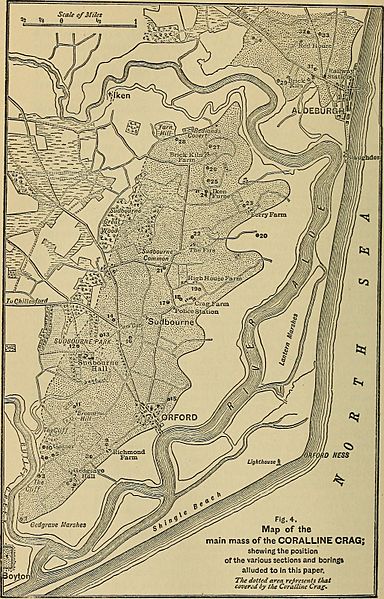Image: The Quarterly journal of the Geological Society of London (1898) (14592624777)

Description: Identifier: quarterlyjourna541898geol (find matches) Title: The Quarterly journal of the Geological Society of London Year: 1845 (1840s) Authors: Geological Society of London Subjects: Geology Publisher: London (etc.) Contributing Library: Smithsonian Libraries Digitizing Sponsor: Biodiversity Heritage Library View Book Page: Book Viewer About This Book: Catalog Entry View All Images: All Images From Book Click here to view book online to see this illustration in context in a browseable online version of this book. Text Appearing Before Image: rather than infavour of, his views, since the shelly seam at the latter place iswithin 15 feet of the base of the formation, which at Sudbourne,in the immediate neighbourhood, is 60 feet in thickness. Strati-graphically, therefore, the Gedgrave shell-beds belong to a lowerpart of the Crag rather than to the supposed upper zone P, to whichthey have been assigned. The evidence upon which I rely for the separation of the LenhamBeds from the Coralline Crag, or which I propose to offer in favourof zones of the Red Crag, is, I submit, of an essentially differentcharacter. We find at Lenham Miocene forms which, so far asthe evidence goes, had ceased to exist in the Anglo-Belgian basinbefore the deposition of the Coralline Crag, and have never sincereappeared; while the older Red Crag deposits contain southernand extinct species, which gradually became less abundant in the ^ Quart. Journ. Geol. Soc. vol. xxvii (1871) p. 116. 2 Monogr. Palseont. Soc. 1866-97; see also Geol. Mag. 1895, p. 511. Text Appearing After Image: Note.—The position of pit 30 should have been indicated just below theletter K (in Kiln), due west of Aldeburgh. Vol. 54.) LBNHAM BEDS AND CORALLINE CKAG. 327 North Sea area, and finally died out altogether, their place beingtaken in the newer beds by arctic and boreal forms, unknown fromthe older formation. The principal difference between the various portions of the lower-or unaltered condition of the Coralline Crag seems to be that in somethe mollusca are chiefly of large, in others of smaller species, a thirdvariety of Crag being composed of comminuted material only. Certainlocalities, however, as for example the Gomer pit, are characterizedby an abundance of univalves, which generally are much lesscommon than bivalves in these beds, but such differences are byno means persistent. Layers of large shells, containing especially■Cyprina islandica, occur in all parts and at all levels in the Crag,as will be seen hereafter, and I am unable to find any bed which iscontinuous except Note About Images Please note that these images are extracted from scanned page images that may have been digitally enhanced for readability - coloration and appearance of these illustrations may not perfectly resemble the original work.
Title: The Quarterly journal of the Geological Society of London (1898) (14592624777)
Credit: https://www.flickr.com/photos/internetarchivebookimages/14592624777/ Source book page: https://archive.org/stream/quarterlyjourna541898geol/quarterlyjourna541898geol#page/n423/mode/1up
Author: Geological Society of London
Permission: At the time of upload, the image license was automatically confirmed using the Flickr API. For more information see Flickr API detail.
Usage Terms: No known copyright restrictions
License: No restrictions
License Link: https://www.flickr.com/commons/usage/
Attribution Required?: No
Image usage
The following page links to this image:

